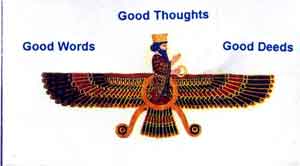|
In the ancient Iran (Persia), there was a special name for every day of the
month. Today's Zoroastrians, continue to use the same names and the same
calendar as their ancestors. These names represented the various Guardians
that protected and helped people. Many of the names were nature-based and
dealt with the elements; while others dealt with the world beyond and the powered
structure. Clearly one can see the harmony and the complex relationships
that existed between humans and their known and unknown worlds.
The names below represent the key ideals of this ancient civilization,
compare these ideals with those of t he American notions of democracy, justice,
equality, individual human dignity, liberty, rule of law and
progress.
- Oormazd = Ahooraa Mazdaa = The Life Giving-Great Wise One.
- Bahman = Good Thought
- Ardi-Behesht = Best Truth and Purity
- Shahrivar = Strong & Progressive Leadership
- Sepandaarmez = Humility and Pure Love
- Khordaad = Good Health & Self Awareness
- Amordaad = Immortality
- Day B-e Azar = Creator
- Aazar = Light or Fire
- Aabaan = Water
- Kheer or Khor = Sun, Sunlight
- Maah = Moon
- Teer = Arrow, Mercury, The Rain Star
- Goosh = World, Life, Existence
- Day B-e Mehr = Creator
- Mehr = Friendship
- Soroosh= Obedience
- Rashn = Justice
- Farvardeen = " Fravar " or Faravahar, the Power of Progress
- Verahraam = Bahraam, Victory
- Raam = Tranquility, Happiness & Joy
- Baad = Wind
- Day B=e Deen = Creator
- Deen = "Vojdaan" The Ability to Distinguish good from bad
- Ard = Erd = "Ashee," Happiness, God Given Wealth
- Ashtadd = Truth, Work
- Aasemaan = Sky
- Zaameeyaad = Earth
- Maantraspand = Good Words
- Anaaraam = Eternal Light
Names & Meanings of the 12 Iranian Mints
|
Spring
1- Farvardeen = Month of "Faravashis", Guardian Spirits and Spirits
of Progress
2- Ardeebehesht = Month of Truth and Justice
3- Khordad = Month of getting to know one-self
|
|
Summer
4- Teer = Month of abundance
5- Amordaad = Month of immortality
6- Shahrivar = Month of good choices
|
|
Autumn
7- Mehr = Month of friendship and trust
8- Abaan = Month of waters
9- Aazar = Month of fire and light of truth
|
|
Winter
10- Dey = Month of giving and name of creator
11- Bahman = Month of good thought
12- Esfand or Espandaarmad = Month of kindness and progressive calm
|
Names of the first five chapters of Zoroaster's songs are listed below.
His songs are known as Gaathaa or Gatha. These five names were used to
make up the missing five days of a 365-days calendar. Since the
Zoroastrian Calendar has 12 months of 30 days each, at the end of the last month
of the year, these names are added to make up the missing five days.
Ahnavad = This chapter is about
God, Zoroaster becoming a prophet and freedom to choose one's religion.
Oshtavad = This chapter is about secrets
of creation, and getting to know one-self and God.
Sepentamad = This chapter is about
creation, choice, and victory of good.
Vahoo Khashatra = This
chapter is about renewing the world and the human role.
Vaheesh-too-esht= This chapter is
about Zoroaster's wish.
Once every four years, a day is added to this seasonal calendar to take care
of the leap year situating. The name used for the 366 day is Oordaad,
meaning "Extra Day Given by God." This Extra day is also known
as Panjeh or Behizak. It is interesting t note that when the names of the
month and day coincided, that day was celebrated. The purpose of these
feasts were to redistribute wealth, make sure every person was taken care of,
and was enjoying life. It also marked the beginning or ending of a harvest
season and giving thanks to Ahuraa Mazdaa. Today's Zoroastrians continue
this tradition.
To
be continued........................
Up
|
